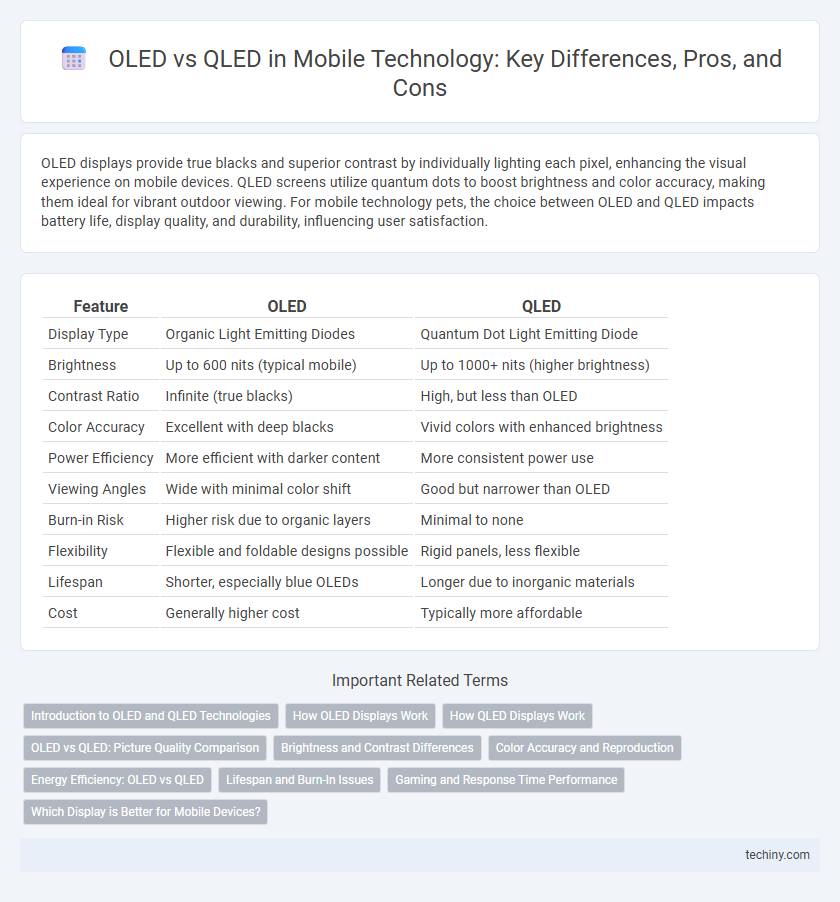OLED displays provide true blacks and superior contrast by individually lighting each pixel, enhancing the visual experience on mobile devices. QLED screens utilize quantum dots to boost brightness and color accuracy, making them ideal for vibrant outdoor viewing. For mobile technology pets, the choice between OLED and QLED impacts battery life, display quality, and durability, influencing user satisfaction.
Table of Comparison
| Feature | OLED | QLED |
|---|---|---|
| Display Type | Organic Light Emitting Diodes | Quantum Dot Light Emitting Diode |
| Brightness | Up to 600 nits (typical mobile) | Up to 1000+ nits (higher brightness) |
| Contrast Ratio | Infinite (true blacks) | High, but less than OLED |
| Color Accuracy | Excellent with deep blacks | Vivid colors with enhanced brightness |
| Power Efficiency | More efficient with darker content | More consistent power use |
| Viewing Angles | Wide with minimal color shift | Good but narrower than OLED |
| Burn-in Risk | Higher risk due to organic layers | Minimal to none |
| Flexibility | Flexible and foldable designs possible | Rigid panels, less flexible |
| Lifespan | Shorter, especially blue OLEDs | Longer due to inorganic materials |
| Cost | Generally higher cost | Typically more affordable |
Introduction to OLED and QLED Technologies
OLED (Organic Light Emitting Diode) technology features self-emissive pixels that produce vibrant colors and deep blacks by individually lighting each pixel without the need for a backlight. QLED (Quantum Dot LED) displays enhance LED-LCD technology by incorporating quantum dot nanoparticles, resulting in brighter images and more precise color accuracy. OLED screens typically offer superior contrast and thinner designs, while QLED panels excel in peak brightness and durability under prolonged use.
How OLED Displays Work
OLED displays function by using organic compounds that emit light when an electric current passes through them, allowing each pixel to produce its own illumination. This self-emissive technology enables true blacks and higher contrast ratios compared to QLED, which relies on a backlight and quantum dots to enhance color. The absence of a backlight layer in OLED results in thinner, more flexible screens ideal for mobile devices.
How QLED Displays Work
QLED displays use quantum dots, which are nanocrystals that emit precise colors when exposed to light from an LED backlight. These quantum dots enhance color accuracy and brightness by converting blue LED light into pure green and red hues, resulting in vivid, high-contrast images. QLED technology typically achieves higher peak brightness levels compared to OLED, making it ideal for well-lit environments and enhancing visibility in mobile device screens.
OLED vs QLED: Picture Quality Comparison
OLED displays deliver superior picture quality with true blacks and infinite contrast ratios due to their self-emissive pixels, enhancing color accuracy and depth in mobile screens. QLED technology uses quantum dots to boost brightness and color volume, providing vibrant images especially in bright outdoor conditions. OLED's faster response time and wider viewing angles make it preferable for immersive mobile visual experiences, while QLED excels in high-luminance settings where visibility is crucial.
Brightness and Contrast Differences
OLED displays deliver superior contrast ratios due to their ability to turn off individual pixels, creating true blacks and vivid colors, which enhances visual depth in mobile technology. In contrast, QLED screens use a backlight that limits black levels but offer higher peak brightness, making them more effective in bright environments or direct sunlight. The choice between OLED and QLED in mobile devices depends on whether deeper contrast or greater brightness is prioritized for the user experience.
Color Accuracy and Reproduction
OLED displays offer superior color accuracy and reproduction due to their self-emissive pixels, enabling true blacks and vibrant colors with exceptional contrast ratios. QLED screens utilize quantum dots to enhance brightness and color volume, delivering vivid images but often struggle with achieving perfect black levels. For mobile technology, OLED's ability to render precise colors and deeper blacks makes it ideal for tasks requiring high-fidelity visuals such as photography and media consumption.
Energy Efficiency: OLED vs QLED
OLED displays offer superior energy efficiency by individually lighting each pixel, resulting in lower power consumption, especially when displaying darker images. QLED screens rely on a backlight, which consumes more energy overall, making OLED more energy-efficient in typical mobile usage scenarios. This energy efficiency advantage contributes to longer battery life in smartphones and other mobile devices equipped with OLED technology.
Lifespan and Burn-In Issues
OLED displays in mobile technology offer superior contrast and color accuracy but typically have a shorter lifespan due to organic material degradation, which can lead to burn-in issues after prolonged static image exposure. QLED screens, relying on quantum dot technology and LED backlighting, provide longer durability and resistance to burn-in, making them more suitable for extended usage without image retention concerns. Users prioritizing long-term device longevity and minimal screen degradation often prefer QLED displays over OLED for mobile applications.
Gaming and Response Time Performance
OLED displays offer superior response times and deeper contrast ratios, making them ideal for fast-paced gaming where motion clarity and color accuracy are critical. QLED screens typically provide higher brightness levels and better color volume, enhancing visibility in varied lighting conditions but may exhibit slightly slower pixel response times. Gamers prioritizing speed and precise visuals often prefer OLED technology for its near-instantaneous response and immersive image quality.
Which Display is Better for Mobile Devices?
OLED displays offer superior contrast ratios and true blacks, enhancing visibility and battery efficiency in mobile devices by individually lighting pixels. QLED technology provides higher brightness levels and better color accuracy, making it ideal for outdoor use under direct sunlight. For mobile devices, OLED's flexibility and power-saving benefits generally make it the preferred choice over QLED.
OLED vs QLED Infographic

 techiny.com
techiny.com